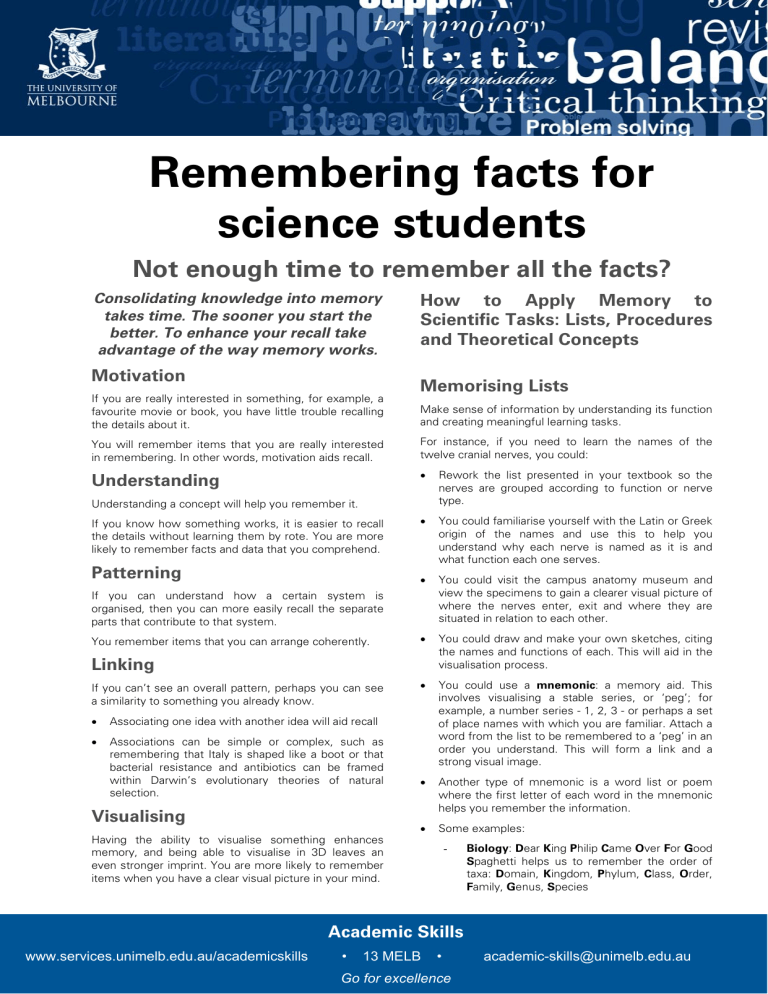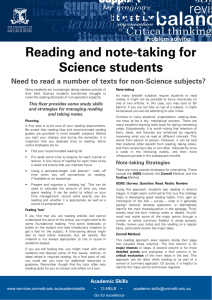Remembering facts for science students

Remembering facts for science students
Not enough time to remember all the facts?
Consolidating knowledge into memory takes time. The sooner you start the better. To enhance your recall take advantage of the way memory works.
How to Apply Memory to
Scientific Tasks: Lists, Procedures and Theoretical Concepts
Motivation
Memorising Lists
If you are really interested in something, for example, a favourite movie or book, you have little trouble recalling the details about it.
Make sense of information by understanding its function and creating meaningful learning tasks.
You will remember items that you are really interested in remembering. In other words, motivation aids recall.
Understanding
Understanding a concept will help you remember it.
If you know how something works, it is easier to recall the details without learning them by rote. You are more likely to remember facts and data that you comprehend.
Patterning
If you can understand how a certain system is organised, then you can more easily recall the separate parts that contribute to that system.
You remember items that you can arrange coherently.
Linking
If you can’t see an overall pattern, perhaps you can see a similarity to something you already know.
Associating one idea with another idea will aid recall
Associations can be simple or complex, such as remembering that Italy is shaped like a boot or that bacterial resistance and antibiotics can be framed within Darwin’s evolutionary theories of natural selection.
Visualising
Having the ability to visualise something enhances memory, and being able to visualise in 3D leaves an even stronger imprint. You are more likely to remember items when you have a clear visual picture in your mind.
For instance, if you need to learn the names of the twelve cranial nerves, you could:
Rework the list presented in your textbook so the nerves are grouped according to function or nerve type.
You could familiarise yourself with the Latin or Greek origin of the names and use this to help you understand why each nerve is named as it is and what function each one serves.
You could visit the campus anatomy museum and view the specimens to gain a clearer visual picture of where the nerves enter, exit and where they are situated in relation to each other.
You could draw and make your own sketches, citing the names and functions of each. This will aid in the visualisation process.
You could use a mnemonic : a memory aid. This involves visualising a stable series, or ‘peg’; for example, a number series - 1, 2, 3 - or perhaps a set of place names with which you are familiar. Attach a word from the list to be remembered to a ‘peg’ in an order you understand. This will form a link and a strong visual image.
Another type of mnemonic is a word list or poem where the first letter of each word in the mnemonic helps you remember the information.
Some examples:
Biology : D ear K ing P hilip C ame O ver F or G ood
S paghetti helps us to remember the order of taxa: D omain, K ingdom, P hylum, C lass, O rder,
F amily, G enus, S pecies www.services.unimelb.edu.au/academicskills
Academic Skills
• 13 MELB • academic-skills@unimelb.edu.au
Go for excellence
Chemistry : M y E normous P enguin B ounces
P retty H igh to remember the series of alkanes
M ethane, E thane, P ropane, B utane, P entane,
H exane
Mind Maps : Write the central theme in the middle of a page and develop sub-ideas around it. This helps to visualise the components of a complex theory.
E.g.:
Computing : P lease D o N ot T hrow S ausage
P izza A way to recall the seven layers of the
OSI Model – P hysical, D ata Link, N etwork,
T ransport, S ession, P resentation, A pplication.
Using mnemonics requires regular revision and repetition. The technique can take a while to master.
You need to weigh up if it might be more profitable learning the data itself.
Other techniques might be to flood your environment with reminders. For instance, place the lists on the fridge, on the back of the bathroom door, above your desk or make a play list and listen to it at different times throughout the day.
Data structures
Software engineering
Computer science
‐ Practical
Algorithms
E.g.
Basic
Programming languages
E.g.
ELAN
Place the words to be remembered into a coherent form to a tune you already know. For example, you could try the twelve cranial nerves sung to The
Twelve Days of Christmas.
Remember, memory is impaired by fatigue, so get plenty of rest and take breaks.
Summary : Read a section or chapter and then write a summary on the main ideas. This helps organise parts of a theory into a shorter form.
Remembering Practical Skills for
Performing Procedures
Explain it to somebody else : Practice explaining the theory in different words for a different kind of audience. For instance, imagine your little sister asked what quarks are - see if you can write it simply. This will help you understand how the theory works as an explanation.
The key to doing well in practical examinations is to make yourself as familiar as possible with the techniques – practice doing the tasks - so that you can perform the procedures without consciously thinking about them.
You could even try explaining it to someone else verbally; someone not familiar with your discipline. If they can understand it, you probably have a good grasp of it.
For practical tasks, enlist your ‘physical’ or kinaesthetic memory, as well as your verbal and auditory memory to get the best results.
There are many ways to learn and remember material.
Use a variety of techniques tailored to the material and your preferred learning style.
If you imagine yourself performing an activity you will stimulate most of the areas of the brain tissue that would be involved in the activity itself.
Works Cited
Strive for a mental image of yourself performing each of the steps in sequence.
Rhoden, C. & Starkey, R. (1998). Studying Science at
University: Everything You Need to Know . Allen and
Unwin, Australia.
Practice the procedure – still performing the necessary movements - even in the absence of the equipment.
Further Resources
To find out more visit – Mind Tools – Memory,
Techniques and Mnemonics’ at http://www.academictips.org/memory/norhyme.html
Learning and Understanding
Theoretical Concepts
Science Mnemonics: http://listverse.com/2007/12/17/top-10-scientificmnemonics/
Theory helps scientists organise ideas. Once you understand the principals, other things fall into place.
Understanding concepts and organising ideas are keys to memory. Some techniques are: http://www.mnemonic-device.eu/science/
www.services.unimelb.edu.au/academicskills
Academic Skills
• 13 MELB • academic-skills@unimelb.edu.au
Go for excellence
V2 1012 LS


